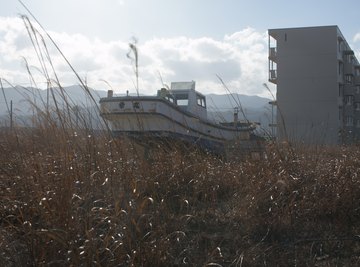
Tsunamis are among the most devastating natural disasters on Earth. The human cost is staggering; since 1850, an estimated 420,000 people have been killed by the enormous waves. Tsunamis decimate the economy and ecology of the areas they strike; they have inflicted untold damage upon coastal property, communities and habitats. Tsunamis and the earthquakes that generate them have immediate aftereffects and long-term ramifications for the inundated areas.
Tsunami Origins
Most tsunamis originate at subduction zones, where a dense oceanic tectonic plate is sinking under lighter continental crust. As friction builds up between the two plates, they can become stuck. When the plates suddenly become unstuck or one of them fractures, energy is released as an earthquake. During a submarine earthquake, vertical motion of a plate displaces the water above it, generating waves that propagate across the ocean surface. Volcanic eruptions and submarine landslides also generate tsunamis. Because the earthquakes and volcanoes that produce them are difficult to predict accurately, tsunamis themselves are almost impossible to predict. When a tectonic disturbance happens, tsunami warnings can be issued, though tsunamis travel at such speeds -- 750 kilometers per hour on average -- that areas near the epicenter have little time to prepare.
Human Impact
The most terrible and immediate human aftermath of a tsunami is loss of life. Tsunamis claimed more 255,000 lives between 1900 and 2009, including the tsunami that originated off Sumatra on December 26, 2004, which killed more than 225,000 people. Tsunamis also destroy vast tracts of infrastructure and property. Loss of life and material is caused by the initial impact of the tsunami wave itself, followed by rapid receding of the water that carries people and debris with it.
Tsunamis continue to affect people after the waters have receded. Tsunamis can overwhelm sewage systems, destroy structures and leave decaying bodies in their wake, leading to long-term health problems related to contaminated water, exposure and increased spread of disease. Psychological damage can also linger; the World Health Organization found that Sri Lankan survivors of the 2004 tsunami suffered from post-traumatic stress disorder two years after the event.
Environmental Impact
Tsunamis can decimate ecosystems on land and in the sea. On land, animals are killed and plants uprooted. Inundation of salt water can promote inland invasion of salt-tolerant plants, such as grasses and mangroves, and loss of soil fertility in coastal farmland. Tsunamis also transport huge amounts of sand, creating fields of underwater dunes and reshaping beaches. The waves’ power can tear up even rocky seabeds; after the tsunami that struck Japan March 11, 2011, Tohoku National Fisheries Research Institute found that large rocks had been overturned and pummeled along the coast, destroying whole communities of sea urchins and abalone, both vital fishery resources. Tsunamis also endanger the local environment through transportation of man-made waste, including building materials; spread of toxic substances, such as asbestos and oil; and release of radiation from damaged nuclear facilities.
Mitigation of Tsunami Aftermath
Proper disposal of waste is key during recovery. Improper burning or dumping of debris could cause secondary damage to people and the environment. During recovery, the top priorities are securing clean drinking water and food for affected people and containing hazardous material. Beyond immediate aid, the cost of reconstruction is a long-term burden. Infrastructure must be repaired before a region’s economy can rebound. Private donations and aid from national and international organizations are crucial in the wake of a tsunami.
References
- National Oceanic and Atmospheric Administration: The Tsunami Story
- NOAA Center for Tsunami Research: FAQ Search
- PLOS Currents Disasters: The Human Impact of Tsunamis: a Historical Review of Events 1900-2009 and Systematic Literature Review
- SMS Tsunami Warning: Tsunamis: The Effects
- Project Syndicate: The Environmental Effect of Tsunamis
- Live Science: Fisheries Another Victim of Japan Tsunami
- U.S. Environmental Protection Agency: Tsunamis
About the Author
Andrew McDonald is a vertebrate paleontologist and writer. He attained a Bachelor of Science in geology at the University of Nebraska-Lincoln and a PhD in vertebrate paleontology at the University of Pennsylvania. He studies the evolution of dinosaurs, primarily in the Cretaceous Period of western North America. McDonald writes articles for the "Space Reporter" and has named four new species of dinosaurs.
Photo Credits
Ken Ishii/Getty Images News/Getty Images
